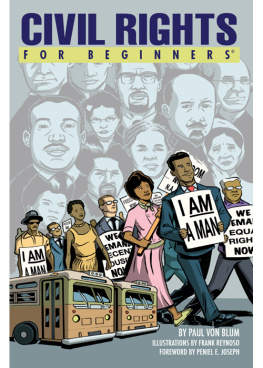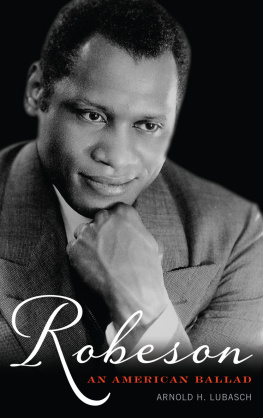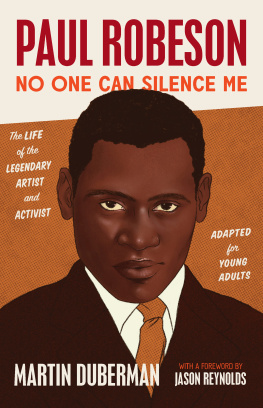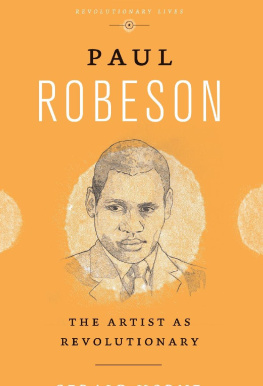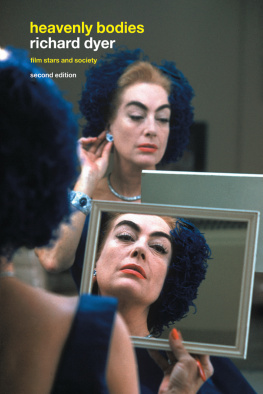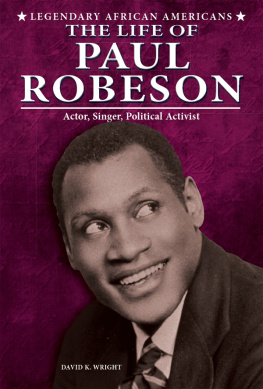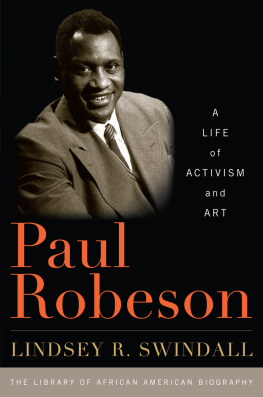Paul Von Blum has given a tremendous gift in bringing the historic sojourn of Paul Robeson to a wide public readership. Robeson's legacy of brilliance, political courage and artistrycaptured in word and image herebeckons all of us to draw inspiration from one of the great radical heroes of the 20th century.
Scot Brown, History Department, UCLA, author of Fighting for US: Maulana Karenga, the US Organization, and Black Cultural Nationalism
Paul Von Blum has given us a lively and highly accessible biography of one of the most important African American political and cultural figures of the 20th century. This is must reading for anyone interested in the life and times of that remarkable man, Paul Robeson.
Steven J. Ross, History Department, University of Southern California, author of Hollywood Left and Right: How Movie Stars Shaped American Politics
The world should know the truth about Paul Robeson, one of the greatest Americans of all time. Paul Robeson For Beginners helps to restore him to his honored place as a giant artist and activist of the 20th century.
Leon Bibb, folksinger, actor, and longtime friend of Paul Robeson
For Beginners LLC
155 Main Street, Suite 211
Danbury, CT 06810 USA
www.forbeginnersbooks.com
Text 2013 Paul Von Blum
Illustrations 2013 Elizabeth Von Notias & Ramsess
This book is sold subject to the condition that it shall not, by way of trade or otherwise, be lent, re-sold, hired out, or otherwise circulated without the publisher's prior consent in any form of binding or cover other than that in which it is published and without a similar condition being imposed on the subsequent purchaser.
All rights reserved. No part of this publication may be reproduced, stored in a retrieval system, or transmitted in any form or by any means, electronic, mechanical, photocopying, recording, or otherwise, without prior permission of the publisher.
A For Beginners Documentary Comic Book
Copyright 2013
Cataloging-in-Publication information is available from the Library of Congress.
ISBN # 9781934389829 ebook
Manufactured in the United States of America
For Beginners and Beginners Documentary Comic Books are published by For Beginners LLC.
First Edition
10 9 8 7 6 5 4 3 2 1
Chapter 1:
INTRODUCTION
PAUL ROBESON WAS ONE OF THE GREATEST RENAISSANCE persons in American history. An exceptional scholar, lawyer, athlete, stage and screen actor, linguist, singer, and civil rights and political activist, he performed brilliantly in every professional enterprise he undertook. Few human beings have achieved his levels of excellence in one field, much less several. Any serious consideration of civil rights and radical politics as well as American sports, musical, theatrical and film history must consider the enormous contributions of Paul Robeson.
And yet, Paul Robeson remains virtually unknown by millions of educated Americans. People typically know him for only one, if any, of the major successes of his life: the concert singer best known for Ol Man River, the star of Shakespeare's Othello on Broadway in the early 1940s, or the political activist blacklisted for his radical views and activism during the era of McCarthyism in the 1950s.
From the late 1950s until the centennial of his birth in 1998, Paul Robeson remained frozen out of the national consciousness, even though he was the most well recognized African American in the world during the 1930s and 1940s. His multifaceted talents were overlooked by his increasingly unpopular political activities; his support for the Soviet Union made him a pariah in his native land during the Cold War following the defeat of the Axis powers. He was excised from the history books, an erasure reminiscent of Stalinistera removal of enemies from photographs and other official Soviet documents. His disappearance from the official record, including from school textbooks and references in mainstream media sources, constituted an egregious example of reputational censorship in the twentieth century. This tragic reality has prevented millions of Americans from understanding Robeson's contributions to American cultural and political life. As historian Joseph Dorinson ruefully noted, Paul Robeson is the greatest legend nobody knows.
The irony of Robeson's disappearance from public consciousness is striking and tragic. Members of the general public and prominent personalities alike held Paul Robeson in the highest regard, including world-renowned political and cultural figures like Eleanor Roosevelt, W.E.B. Du Bois, Pablo Neruda, Sergei Eisenstein, Jomo Kenyatta, Jawaharlal Nehru and many more. American athletic and entertainment figures like Joe Louis, Canada Lee, Lena Horne, Dizzy Gillespie, Zero Mostel, Odetta, Sidney Poitier, Harry Belafonte, James Earl Jones and scores of others viewed Robeson as a cultural giant and moral role model, whose trailblazing efforts paved the way for decades of African American advancement in every walk of life. When Paul Robeson's life ended in loneliness and obscurity in 1976, a deep stain on American history surfaced dramatically with the media announcements of his death. This stain will take decades to wash out of the American social fabric.
The long overdue restoration process has begun. Several events and creative developments converged after Robeson's death to propel him back into national recognition, and reverse the process of reputational obliteration. An early example occurred in 1978 when Phillip Hays Dean wrote and produced the play Paul Robeson. This dramatic effort chronicled the life of Paul Robeson from his childhood to his death, and focused on the racism he encountered and combated in every aspect of his life and career. Numerous actors played the starring role of Robeson, notably James Earl Jones, Ben Guillory and Avery Brooks. While the play was not without its share of controversies and mixed critical responses, it exposed Robeson's life and work to audiences, many of which were uneducated about his accomplishments.

The 1979 production and release of the short documentary Tribute to an Artist, which Saul J. Turrell directed and Sidney Poitier narrated, continued the process of public reeducation about Paul Robeson. This engaging film, which received the Academy Award for Documentary Short Subject in 1980, chronicled Robeson's versatile life as an athlete, artist and activist, as well as his blacklisting, relying on news and film clips, interview segments and photographic still shots. The presence of the universally respected and admired Poitier in this documentary added substantial gravitas to the project and bolstered the drive to restore Robeson's presence in American cultural and political history.
Official Hollywood also acknowledged Paul Robeson in 1979. The Hollywood Walk of Fame consists of more than 2,400 five-pointed stars embedded in the sidewalks of Hollywood Boulevard and Vine Street in Hollywood, California. These stars represent achievement in every aspect of the entertainment industry. Honorees include actors, directors, producers, musicians and more. The Hollywood Chamber of Commerce administers the Walk of Fame and the Hollywood Historic trust maintains it. In 1978, the selection committee, reflecting the anti-Robeson bias of the era, voted against a star for him. Widespread protest from more enlightened entertainers, politicians and civic leaders caused the committee to reverse its decision and a Robeson star was installed.


